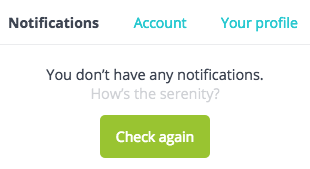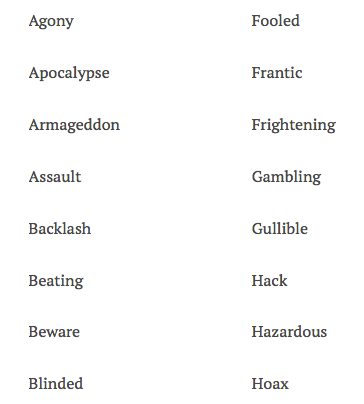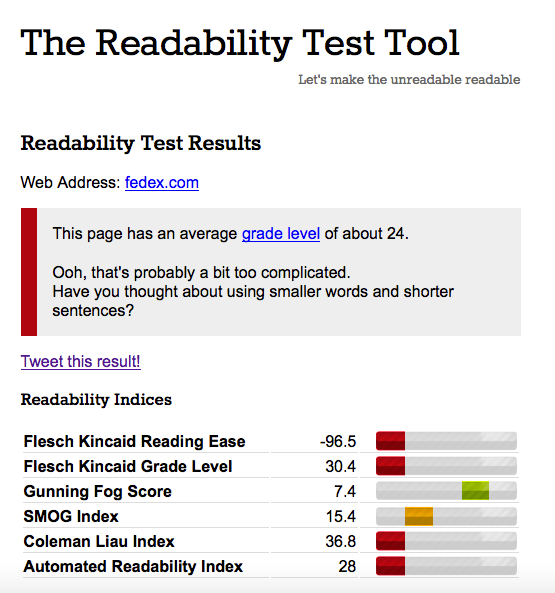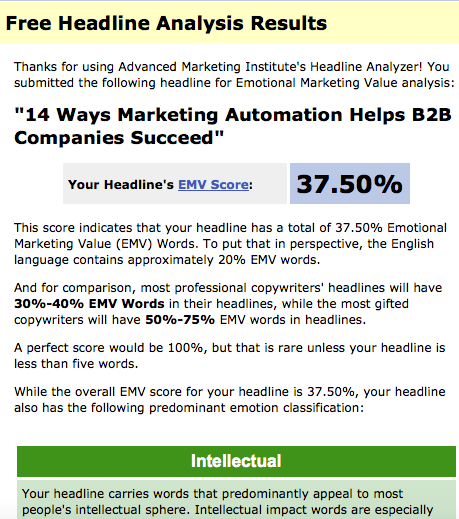Editor’s note: Because great writing and technology continue to evolve and are essential in any successful content marketing plan, we’ve updated this post.
Consuming great writing is like listening to a great singer. If the performer makes an emotional connection with me – even though she misses a few notes – I eagerly listen to the rest of the song and anticipate the next performance.
I share helpful lessons on powerful and effective text with seven real-life examples, then provide 10 content writing tips and many more tools to help you win over as many of your readers as possible.
Lesson 1: Power up video text
U.K.-based web designer Purplefeather created the powerful Change Your Words, Change Your World video. In it, a four-word plea (I’m blind. Please help.) is changed into a nine-word sentence (It’s a beautiful day and I can’t see it). The text transformation generates far more compassion.
Since its 2010 debut, the video has been viewed over 22.5 million times and received more than 15,000 comments on YouTube.
Lesson 2: Create something that must be read
In 2013, the National Agency for the Fight Against Illiteracy in France earned accolades for its print ad campaign. Viewers had to read the ads to discover what they were really about – not only creating awareness of the fight but demonstrating the actual value of literacy.

Lesson 3: Get to the point
Visual content is a useful vehicle for your messaging. Market Domination Media took a meta approach to explaining why infographics work by creating an infographic. Note that the text is minimal and gets straight to the point, stressing facts over long descriptions.
Infographic by: Market Domination Media
Lesson 4: Don’t be so serious
Design program Canva uses light-hearted content touches to connect with its readers, such as this simple way to mention notifications.
 Lesson 5: Think smart
Lesson 5: Think smart
Headline writing involves many challenges – tone, length, etc. This headline from Business Insider appears to be straightforward – good use of a numeral, direct, etc. But the word smarter caught my attention and elevated the post’s value in my mind.
Lesson 6: Use text to help visualization
The Dropbox blog provides numerous examples of how to use the service. I like the crisp writing that consistently includes realistic examples based on diverse needs.
Lesson 7: Explain succinctly
Zendesk elevates its customer service by writing briefly to illuminate the difference among customer support, customer self-service, and customer engagement. With a few words, Zendesk communicates to its customers that it cares about their relationship and wants them to access the best resource to help them right away.
Tip 1: Know your audience
You need to speak their language, but it doesn’t mean settling for jargon that can clash with creative phrasing. Typically, an informal, conversational approach works best when you’re creating content.
Other content writing suggestions include:
- Focus on actionable content that someone can use in their lives or jobs right away.
- Write in first person or second person.
- Be careful with humor, which can fall flat for the reader.
- Use profanity rarely because it can throw off someone who may wonder why the content includes those words.
- Don’t be so creative that a reader struggles to detect your main point.
- Avoid starting sentences with vague words like this or that.
- Link to other websites, newsletters, and blogs because the links provide added value to visitors and help establish your credibility.
RECOMMENDED FOR YOU:
Tip 2: Get visitors to take the right actions
Sometimes it’s a simple word or phrase that can prompt someone to take the next step. Buffer offers a list of 189 words, including words that focus on exclusivity.
RECOMMENDED FOR YOU:
Tip 3: Remember that length depends on the context
It’s easy to stick to some content length rules and preferences.
For example, you will want to maximize the 35 characters you get on each line of a Google ad. With social media, you might improve engagement by stopping well short of the maximum character limits.
It gets tougher with website pages, articles, and blog posts. I understand that short pieces (let’s say anything under 500 words) are easier to consume for online readers. But longer content can draw in people as well. Visuals in the core content and within the site architecture can support your text.
Odds are that your agency or company will have policies that control length. But there should always be exceptions.
If you don’t write enough, you disappoint someone by not devoting sufficient attention to a topic. If you provide too many details, you might overwhelm a reader who might miss your primary ideas.
Editors and writers should agree on whether the article is a suitable length. You can discard information that doesn’t quite fit. But in the content writing and editing process, you might identify opportunities to use some portions for future content (with additions or modifications).
From a search engine optimization perspective, longer content is always best. A website, for example, can get by with shorter pieces if it becomes authoritative through its age, the number of pages, inbound links, and more. However, extended content often helps generate high rankings for targeted keyword phrases and similar words.
RECOMMENDED FOR YOU:
Tip 4: Ensure that your content can be scanned (especially with websites)
Readers will skip many of your words. Make it easy for them to discover your key points by including:
- Short paragraphs
- Subheads
- Bulleted lists
- Bolded text
- Words in color
- Links
You don’t need to write long sentences to get your point across. Short ones will work in your favor. It’s the same thing with words. Here are some examples (sometimes a few short words sound better than one long word).
- Indicate show
- Eliminate get rid of
- Utilize use
- In order to to
- Facilitate help
- Obtain get
RECOMMENDED FOR YOU:
Tip 5: Understand fair use
As a content writer, you may occasionally use other content. It’s not always enough to simply use quotation marks and cite the source.
Fair use depends on several factors, including whether your content is used for commercial purposes and its potential impact on the market value of the copyrighted work.
I mostly worry about the length of the original source. If I quoted 100 words from a 250-word blog, I think that would be too much. A lawyer would have the best advice, but I would limit the quote to 25 words in that case. Books are a little easier. If you quote 300 words from a 150-page book, I believe you would be fine. Poems and song lyrics are a danger zone because they’re often short. I’ve cited as little as possible from them. It’s always best to get legal counsel before publishing the final content.
RECOMMENDED FOR YOU:
Tip 6: Evaluate sentence structure with the Hemingway App
Content writers have many tools to reference to make their jobs a little easier and to improve their work. Among the best is the Hemingway App, which provides immediate feedback on content structure, including sentence formatting. With the website version, replace the default text with your own.
RECOMMENDED FOR YOU:
Tip 7: Create compelling content with the right words
Jon Morrow of Boost Blog Traffic offers an extensive collection of words that can make a difference in what you write: 317 Power Words That’ll Instantly Make You a Better Writer.
Tip 8: Use a blog topic tool if you need inspiration
HubSpot’s Blog Topic Generator works well to get your creative content writing juices flowing. All you have to do is fill in the fields with three nouns to get blog topic ideas.
Tip 9: Evaluate the complexity of your sentences
The Readability Test Tool scores your content, including the grade level and the complexity of words.
Tip 10: Analyze the impact that your headlines could have on readers
Size up headlines with the Emotional Marketing Value Headline Analyzer.
RECOMMENDED FOR YOU:
How do you succeed with content writing? What tools and resources do you rely on the most?
Want your audience to take notice and take action on your brand’s content? Our newest Guide to Essential Content Marketing Tactics has tips, insights, and ideas that can help increase your success with today’s top content marketing plays.
Cover image by PazMadrid, morgueFile, via pixabay.com
Please note: All tools included in our blog posts are suggested by authors, not the CMI editorial team. No one post can provide all relevant tools in the space. Feel free to include additional tools in the comments (from your company or ones that you have used).












